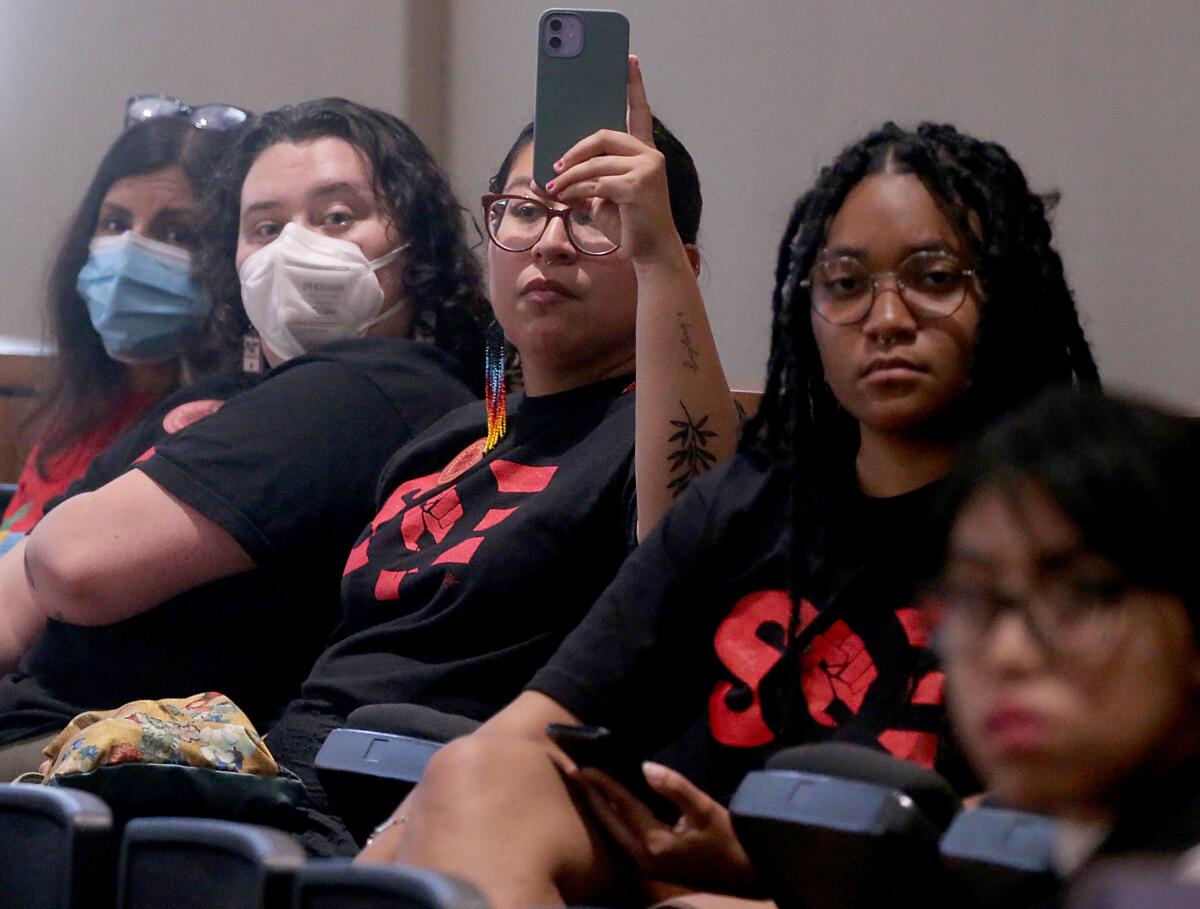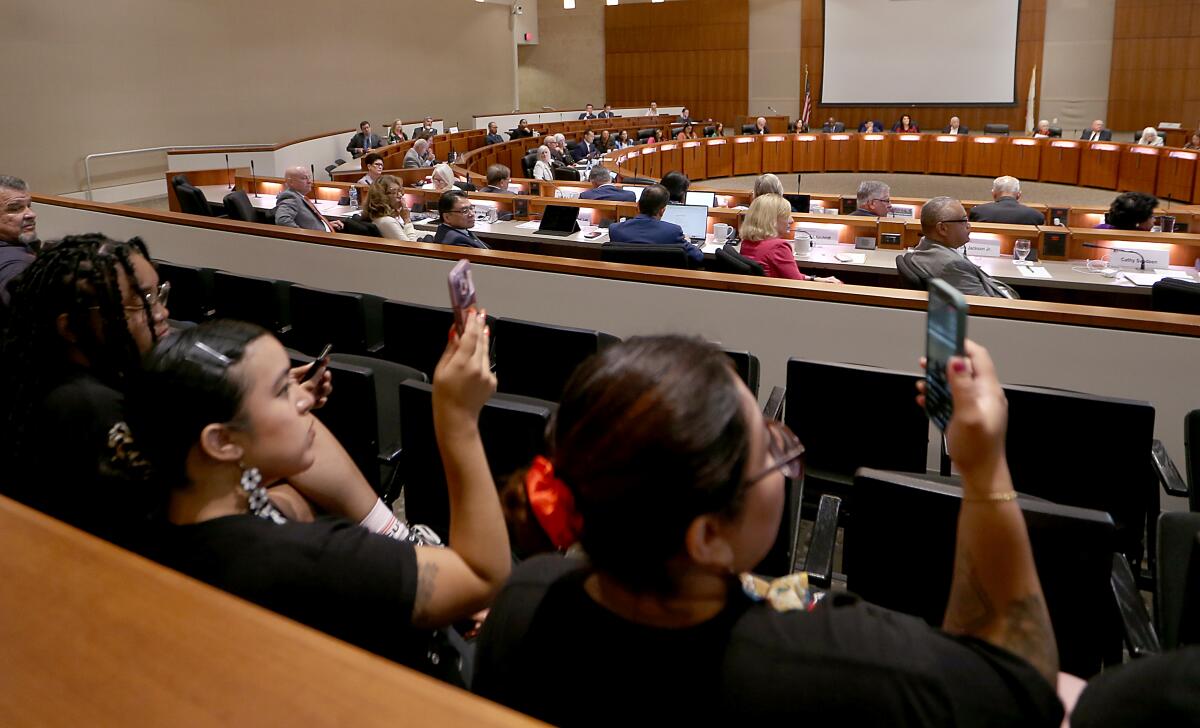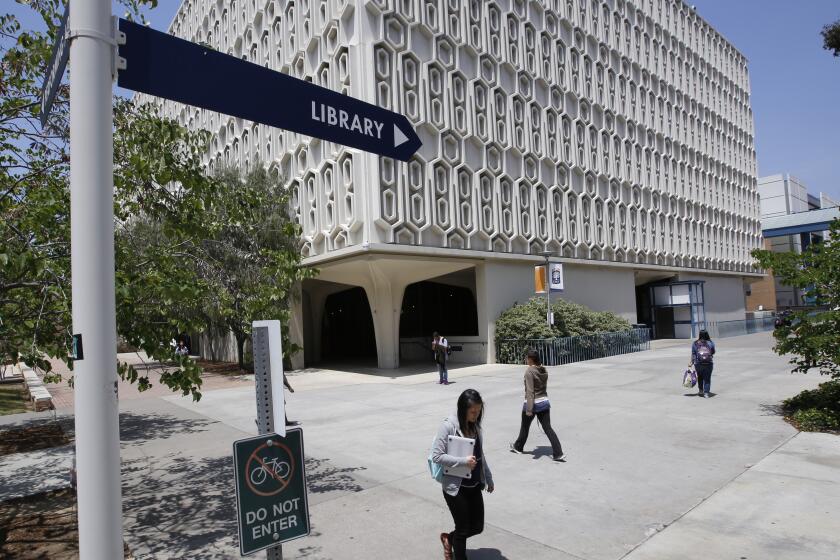Cal State students: Brace yourselves for the possibility of a 6% tuition hike every year

- Share via
California State University leaders are moving toward imposing an annual 6% tuition increase that could generate hundreds of millions of dollars for the cash-strapped system, with undergraduates paying $342 more the first year alone, a plan that drew protests Tuesday from students who said they can’t afford the hike.
About 12 of the 25 members of the Board of Trustees expressed support for a tuition hike, with a student trustee sharply opposed.
“We have students who are the main providers for their household who have to work to contribute to the family’s finances,” said Diana Aguilar-Cruz, a voting student trustee. “Our voices have been ignored throughout the years.”
The proposal under discussion calls for annual undergraduate and graduate student increases beginning in the 2024-25 academic year. Trustees are slated to vote on the plan in September.
For full-time undergraduate students, the proposal would bring tuition in the first year to $6,084 from $5,742. Each subsequent year would bring another 6% increase, with trustees evaluating the increases every five years. By the 2028-29 academic year, a full-time undergraduate student would pay $7,682 a year.
About 60% of the system’s 460,000 students who have their full tuition covered through grants, scholarships and waivers will continue to have their costs covered, officials said.
Cal State officials say the hike is necessary to contend with a nearly $1.5-billion budget gap across the 23-campus system. A report released in May found Cal State is significantly underfunded, with its two main revenue sources, the state and tuition, covering only 85% of what it needs for student services, academic support, instruction and other expenses in the 2021-22 year.
A new report reviewing Cal State’s finances found the university system is coming up 15% short of its total costs, leaving an almost $1.5-billion funding gap. The report recommends implementing tuition increases.
The gap means administrators are forced to make difficult choices forgoing building renovations and wage increases to cover costs for other expenses. And the gap could worsen if the system doesn’t raise more money in the coming years, leading to fewer course offerings and student support, which could prolong the time it takes for students to graduate, officials said.
Money from the tuition increases would go toward providing more academic support to boost graduation rates, improve research and internship opportunities for students, and enhance course options.
Trustee Lillian Kimbell said it is part of the board’s responsibility to make difficult decisions.
“It’s painful but that’s what we’re here to do,” she said. “We’re not here to preside over the degradation of the institution.”
Several trustees agreed that raising tuition is necessary to create financial stability in the system after going without an increase all but once in the last 11 years.
Although members who spoke at the meeting were generally supportive of raising tuition, they rejected the idea of allowing tuition increases to continue annually without end. They supported ending the rate increase after five years, unless the board votes to continue it.
“We really need to do something here in an urgent way,” said trustee Douglas Faigin, adding he would support the tuition hike for up to three years, but urged against developing an “eternal tuition increase.”
Trustee Eleni Kounalakis, the state’s lieutenant governor, raised doubts that the system would remain affordable for many students.
“We’ve heard about this notion that this will only affect 40% of our student body — $840 million raised in five years, put on the backs of 40% of our students,” said Kounalakis, who appeared by video. “How can we possibly contemplate that kind of money, while we are talking about students who we know are not wealthy.”
She urged trustees to delay voting on the proposal until after September, when more students are on campus to provide input on increases and after the system announces its new chancellor.
And she said she was alarmed the system would impose an ongoing increase without revisiting it at least every two or three years, calling it an “abdication of the duty of the trustees.”
Interim Chancellor Jolene Koester said the board should vote on the tuition proposal in September to give families adequate time to prepare for increases in the 2024-25 year.
“Everything we do in the university ultimately is to benefit students,” she said. “And we are so far behind.”
Students and unions representing Cal State workers loudly protested the proposed hikes outside the Long Beach meeting, waving signs that read “No tuition increases” as they drummed plastic buckets and blew whistles.
They argued it is already too costly to attend CSU, with many students having to work multiple jobs to pay for rent, food and other essentials. Several students urged the trustees to reduce campus police budgets and reallocate the money to pay for student needs, including mental health services.

As noise from the protest outside carried into the meeting room, demonstrators with Students for Quality Education, a grassroots organization that advocates for progressive campus policies, urged the trustees to rethink tuition increases.
Angelmarie Taylor, a fourth-year student at Cal State Channel Islands, said she works three jobs to cover her tuition. She had been eligible for Pell Grant, money that fully covered her tuition. But Taylor, a first-generation college student, had to work to pay rent, utilities and other expenses. Balancing work and school became too overwhelming, and her grades fell below the 2.0 GPA needed to maintain her Pell Grant.
“We are not a bank that you can tap into to fix your mistakes,” she told the trustees during public comments. “We are already broke paying for your already overpriced, low-quality education. Do not raise our tuition.”
The Cal State Student Assn., which represents the system’s 460,000 students, also objected to the increase, taking issue with the indefinite nature of the proposal. In a statement they said the plan “lacks measurable outcomes” and fails to detail alternative plans for raising money.
“The proposal does not serve the best interest of students,” the group said. “It threatens to burden students, especially those struggling with the pandemic aftermath and escalating living costs.”
They were backed by the Cal State Faculty Assn., which represents the system’s 29,000 professors, lecturers, librarians and counselors. The union, one of several alliances representing CSU workers, are pushing for wage increases but does not support charging students more to pay for raises.
Charles Toombs, president of the Cal State Faculty Assn., said the system should instead look to curb administrative bloat, which he said has resulted in “endless administrative positions.”
“The majority of CSU students are Black, brown, other students of color — marginalized and underrepresented,” he said. “This is not the time for these students to carry the financial burden of the CSU.”
A new report reviewing Cal State’s finances found the university system is coming up 15% short of its total costs, leaving an almost $1.5-billion funding gap. The report recommends implementing tuition increases.
Since the mid-1990s, the state’s contribution to CSU’s operating budget dipped from 80% to 60%. The state fully funded the system’s annual budget requests only once in the last decade, while costs have risen because of inflation. Tuition has remained mostly flat over the last decade and is still among the lowest in the country.
The state has taken steps in recent years to help the system: Gov. Gavin Newsom has promised an annual 5% base funding increase through 2026-2027 in exchange for commitments to expand access and equity.
But the increase in state funding alone is not enough to pay for all the costs the CSU needs, according to the report.
“We really care about affordability,” said Julia Lopez, a CSU trustee who helped lead the group that produced the report on the system’s finances during a May meeting. “We really care about making sure that we don’t do anything that would in any way put barriers in terms of people attending the CSU.”
The California State University Board of Trustees is expected to vote on tuition increases later this year.
Marcia Moran, 24, explained why a hike would be difficult for her. She transferred to Cal State Los Angeles from a community college and was eligible for Pell Grants until this summer. Students can receive Pell Grants only for 12 academic terms, which Moran said she exhausted at the end of the spring semester.
She paid the $1,000 tuition for summer session out of pocket and plans to draw loans and pick up more work delivering food for Uber Eats and Postmates to afford tuition next academic year.
Moran said she doesn’t see how tuition money is benefiting students as it is — some buildings at Cal State Los Angeles lack air conditioning, and the university doesn’t employ enough counselors. And she believes university presidents and top administrators — many of whom draw an annual salary of more than $300,000 and receive tens of thousands of dollars each year in housing allowances — are out of touch with the lives of CSU students, many of whom come from low-income families.
“The fact that they still want to increase tuition, thinking it would not affect us in any way — it’s very telling that they don’t understand the actual struggles and hardships that we have to face,” she said.
Angelina Collins, 21, said she already borrows $6,000 in loans each year to cover her tuition at Cal State Northridge.
She makes about $1,100 each month from an internship, working as a student assistant and serving on the Board of Directors at her university. After rent, she’s left with about $300 each month for other expenses.
The fourth-year psychology major plans on pursuing a master’s degree in the Cal State system in hopes of working as a mental health therapist. But the financial demands have drained her.
It’s left her wondering, “Is this really worth it?”
More to Read
Sign up for Essential California
The most important California stories and recommendations in your inbox every morning.
You may occasionally receive promotional content from the Los Angeles Times.













